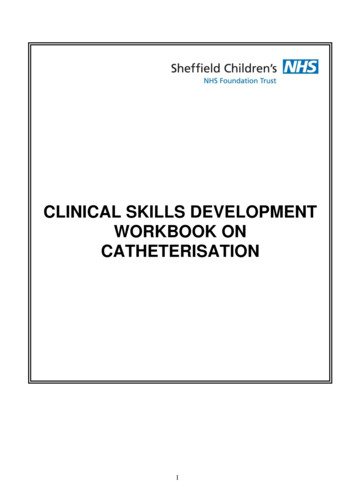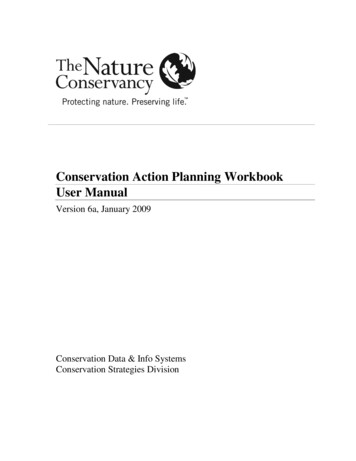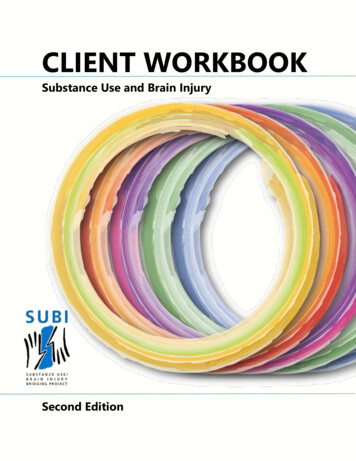
Transcription
CLINICAL SKILLS DEVELOPMENTWORKBOOK ONCATHETERISATION1
CONTENTSAims & Intended Learning OutcomesIntroductionThe Normal Urinary Tract -anatomy and physiologyExercise 1Types of catheterisationIntermittent catheterisationIndwelling catheterisationSuprapubic catheterisationUrinary stomasExercise 2Risks associated with catheterisationInfectionDevelopment of infectionTrauma/tissue damageCatheter blockageExercise 3Selection of catheterDrainage EquipmentExercise 4Discharge home with catheterisationExercise 5Key PointsReflection Learning OutcomesReferences2
AIM & INTENDED LEARNING OUTCOMESAimThe aim of this clinical skill development workbook is to enhance your professionalpractice and contribute to the overall care of catheterised patients by helping you to;a) Care for a child with an indwelling catheterb) Minimize, prevent/ manage catheter related problemsc) Where appropriate to perform safe, effective male or female catheterisation inchildren.This workbook is to be used in conjunction with the Trust guidelines for theManagement of catheters in the hospital settingIntended Learning OutcomesAt the end of working through this workbook you should be able to:Recall key facts about the normal urinary tract.Summarise different options available for patients requiring urinarycatheterisation and the reasons why.Demonstrate safe and effective management of indwelling catheters and theunderlying rationaleExplain main risks and common complications which can occur when patientsuse long-term urinary catheters.Identify how these problems may be prevented or managed in practice.Have a good working knowledge of the different catheters and drainageequipment available and its correct and safe usageUnderstand the importance of accurate and comprehensive documentationand discharge planning3
INTRODUCTIONUrinary tract infections account for approximately 23% of all health care associated infections inadults. Approximately 8%of these are associated with the presence of an indwelling catheter.Of those who develop bacteriuria, 2 – 6% develops urinary tract infection, of which 1 – 4%develop bacteraemia with a mortality rate of 15 -30%.The risk of infection is associated with the method and duration of catheterisation, quality ofcatheter care and susceptibility of the host. It is essential therefore, that careful assessment ismade of the need for catheterisation and that the most appropriate equipment is selected, usedand managed safely to minimise the risk to patients.In the absence of data relating to children it is prudent to assume similar if not greater infectionrisks than with adults.The main principles guiding catheterisation and catheter management are therefore associatedwith minimising infection risk and maximising comfort, dignity and concordance. These are asfollows;1) Only catheterise when all other methods of management are not appropriate.2) Select most appropriate method and equipment for catheterisation depending onpurpose and length of time catheterisation is needed.3) Continuously review need for catheter and remove it at the earliest opportunity4) Catheterisation should only be performed by trained and competent personnel. It is theresponsibility of staff undertaking the procedure and staff caring for catheters to ensurethey have the knowledge and skills for safe and effective management.This workbook is designed for all staff caring for catheters and is a comprehensive trainingprogramme. The workbook and exercises should be completed alongside practical assessmentof ability to care for a child with a catheter. It must also be completed as part of training andassessment of insertion of catheters.Assessment and practical observation of both, management of catheters and catheterisation,is provided by members of the urology /continence team, clinical skills team or designatedtrained ward staff.4
THE NORMAL URINARY TRACTThe bladder is composed of two main parts: the body within which urine collects and theneck, a funnel-shaped extension of the body, which connects with the urethra.The smooth muscle of the bladder is called the detrusor muscle and when contracted it canincrease the pressure in the bladder to 40 to 60 mmHg. On the posterior wall of the bladder,immediately above the bladder neck, is a small triangular area called the trigone. At thelowermost apex of the trigone the bladder opens through the bladder neck into the posteriorurethra. The two ureters, coming from the kidneys, enter the trigone at the uppermostangles of the trigone. The muscle in the area of the bladder neck forms the internalsphincter. Beyond the posterior urethra, the urethra passes through a circular layer ofmuscle - the external sphincter - which is under voluntary control.In anatomy books the bladder is usually depicted in its full state, with a very obvious cavity.However, it is important to remember that the bladder is a collapsible muscular sac andwhen empty the mucous membrane lining falls into folds except in the area of the trigone.The female urethra is about 4 cm long. The male urethra is about five times as long (20cm) and is surrounded at the bladder end by the prostate gland.5
ANATOMY OF THE BLADDER6
Nervous innervation of the bladderThe activation and co-ordination of the bladder and sphincter region are controlled throughthe three sets of peripheral nerves.1 The sacral parasympathetic nervesThese nerves supply the pelvic nerve which comprises of sensory (afferent) nerves thatcarry impulses towards the central nervous system, and motor (efferent) nerves that carryimpulses away from the central nervous system. The sensory fibres supply the detrusorand the bladder neck area and as the bladder stretches, signals are sent to the sacralsegment of the spinal cord (S2 –S4) .From here they are transmitted in the ascendingventral columns of the cord to the higher centres of the brain. When these nerves arestimulated during micturition they bring about the contraction of the detrusor and thefunnelling effect of the bladder that initiates voiding.2 The sympathetic nervesSympathetic nerves also consist of motor and sensory fibres originating in a differentregion of the spinal column (T1-T2). It is thought that these nerves influence the inhibitioncycle in the bladder and sensory nerve fibres relay impulses in response to painful stimulisuch as over-distension, spasm, inflammation or stones.3 The somatic motor and sensory nervesThese supply the wall of the urethra and the pelvic floor primarily from S3 (but also tosome degreeS4 and S2) becoming the pudendal nerve which carries both motor andsensory fibres. The pudendal nerve is derived from the sacral plexus.The bladder normally fills at a rate of 1 ml per minute from each ureter but this can beincreased with kidney disease, increased fluid intake or pharmacology.As the bladder fills with urine the pressure rises within it. Superimposed on these pressurechanges are periodic acute increases in pressure lasting from a few seconds to more than aminute these micturition reflexes start when sensory receptors in the bladder wall, andespecially the posterior urethra, detect the degree of stretch in the bladder wall and sendsignals to the spinal cord. These signals are conducted back to the bladder where theycause a further reflex contraction of the detrusor muscle. This cycle is repeated again andagain until the bladder is strongly contracted. If the higher centres in the brain preventmicturition, the bladder pressure returns to its basal tone. However, as the bladderbecomes more and more full, micturition reflexes occur with increasing frequency andstrength. When a convenient time for micturition occurs, the higher centres relax theexternal urinary sphincter, and the urine is expelled by the contracted detrusor.7
EXERCISE 1DRAW THE BLADDER AND KIDNEYS AND EXPLAIN HOW THE BLADDERWORKSLABEL THE DIAGRAMS OF THE MALE AND FEMALE ANATOMY8
URINARY CATHETERISATION: OPTIONS AVAILABLECatheters may be inserted into the bladder viaa) the urethra (urethral catheterisation) this can be intermittent or indwellingb) through a small incision in the anterior abdominal wall (suprapubic catheterisation)c) a stoma e.g. ureterostomy, vesicostomy or through the umbilicus via a Mitrofanoffstoma.Urethral Catheterisation- IntermittentUrethral catheters may be inserted each time the bladder requires emptying and thenremoved following completion of drainage. Research evidence associates this method withthe least number of complications and lowest risk of infection. ( Lindhall et al, 2007).The onlycomplication is minor trauma which can result in haematuria.For some children however for instance those in wheelchairs, with dexterity problems orwho experience unacceptable sensitivity or discomfort (mainly boys) it may not be a suitableoption.Intermittent catheterisation is a clean procedure for children, parents and carers in thecommunity, however, carers undertaking the procedure are required to wear non – sterilegloves. For hospital staff, due to the risks of hospital acquired infection, it is always a sterileprocedure. Procedural guidelines for intermittent catheterisation are within the TrustGuidelines for management of urethral catheters.1. Intermittent catheterisation2) Indwelling Catheterisation,This is where a Foley (ballooned catheter) is inserted into the bladder via the urethra.The catheter is left in situ retained by inflating a balloon at the catheter tip with the correctvolume of sterile water. A drainage system can then be selected and connected to theend of the catheter. The bladder can be drained using this type of catheter eitherintermittently by either putting on a catheter valve which can be open and shut orcontinuously by attaching a drainage bag to allow free drainage. The choice of drainageoption depends on medical reason for catheter and will be advised by medical staff.9
If continuous drainage is not necessary the use of a catheter valve will- allow greater freedom- encourage normal activity of the bladder- avoid contact with urine therefore reducing risk of infectionMale urethral catheterisationThis can be undertaken by male or female staff provided appropriate training andassessment has been completed.Potential problems include:Sensitivity when inserting catheter. Use of anaesthetic gel can help reducediscomfortStricture formation- pre-coated catheters should be used to prevent incidenceUrethral trauma on insertion or removal of catheterSee Trust guidelines for stepped procedure for indwelling urethral catheterisation10
3) Suprapubic CatheterisationSuprapubic catheters can be inserted under local or general anaesthetic (GA) however they arealways inserted under a GA with children. They may be attached to a drainage bag forcontinuous drainage or may be used with a valve for intermittent bladder emptying.Supra pubic catheterisation carries less riskof infection for long term use than anindwelling urethral catheter. It is also morecomfortable and less restrictive andtherefore is often the choice for childrenrequiring longer term bladder drainage.It can be used short term for Urodynamics,following Hypospadius or urethral surgeryusing a non- ballooned catheter such as aCystofix however generally a Foley catheteris the catheter of choice for suprapubicdrainage.Samples of urine are sometimescollected from a supra pubicaspiration when a child is acutelyill using a needleComplications of suprapubic catheterisationComplications of suprapubic catheters are minimal:Over-granulation of catheter site- causes yellow discharge around site is oftenconfused with infectionCatheter blockage/ leaking around siteTube displacement due to balloon deflation or being pulled out accidentally.Suprapubic catheters can be changed in the community by parents/children or in hospital.Sometimes entonox or sedation can be used if necessary and occasionally it may require ageneral anaesthetic if particularly problematic.11
URINARY STOMAS (Ureterostomy, Vesicostomy and Mitrofanoff)1) Ureterosomy –This is a method of diverting the flow of urine away from the bladder via the ureters by creatingan opening (stoma) onto the surface of the abdomen. The more common types ofureterostomy are:1) Single ureterostomy this procedure brings one ureter to the surface on the abdomen2)Transuretero ureterostomy this procedure brings both ureters to the skin surface on theabdomen through a single stoma3) Bilateral ureterstomies this procedure brings both ureters to the skin surface on each side ofthe abdomenThe stoma will drain urine continuously either into the nappy (babies) or into a drainage bag(older children)123ComplicationsIrritation, soreness and infection of skin around the stoma site can be caused by direct contactwith urine. This can cause drainage bags to leak and need frequent replacement. Appropriatebarrier creams/skin treatments may be used to resolve this problem.Narrowing (stenosis) of stoma could cause obstruction of urine flow from the kidney. Dailycatheterisation of the stoma is usually carried out using a short intermittent catheter to ensurethe stoma remains patent. The procedure is the same as that for intermittent catheterisation.12
2)Vesicostomy –This is a surgically created connection from the anterior bladder wall to the skin surface on thelower abdomen for children who are unable to void in the usual way due to problems such as:Congenital defect, Spinal cord injury or defect, renal problems / voiding dysfunctionIf the child /parent are unable or unwilling to carry out urethral catheterisation, then avesicostomy may be chosen as a temporary or permanent option. Urine will drain continuouslyfrom the vesicostomy into a nappy (babies) or into a drainage bag (older children)Intermittent catheterisation of the stoma is again usually necessary at least daily with anintermittent catheter to ensure the bladder is completely emptied of urine to prevent stasis andinfection. This will also ensure the stoma remains patent and prevent obstruction of the flow ofurine.Complications- Irritation, soreness and infection of the skin around the stoma site due to direct contactwith urine. This can cause drainage bags to leak and need frequent replacement.Appropriate barrier cream/skin treatments may be used to resolve this problem. If skin isseverely affected, a Foley(balloon) catheter may be temporarily inserted into thevesicostomy with a closed drainage system attached to allow drainage of the bladder andprevent direct contact of skin with urine until the problem is resolved13
3) Mitrofanoff StomaThis is a channel constructed from the appendix, or small intestine which connectsthe bladder to the surface of the skin behind the umbilicus. It is tunnelled into thebladder in an anti – reflux manner to create a “valve” to prevent leakage of urine upand out of the channel. An intermittent catheter can then be passed through thechannel into the bladder every three or four hours or when the bladder is full. Childrenare usually able to do this without help but may need support / supervision dependingon age and ability. Regular emptying of the bladder this way will ensure that all urineand mucous is removed to prevent urine infections, protect the kidneys and achievedryness. The procedure is similar to that of intermittent urethral catheter except thatthe catheter is passed down the Mitrofanoff channel rather than the urethral opening.(See Guidelines for Catheterisation of Mitrofanoff stoma). It is most commonly usedwhen intermittent catheterisation is impractical or impossible however it is majorsurgery and requires the child and parents to be motivated and compliant to manageaftercare and potential complications.ComplicationsThe channel is surgically made and therefore is susceptible to narrowing ( stenosis) makingit difficult to insert a catheter. If this occurs advice must be sought immediately especially ifthe child has also had a bladder augmentation as there can be a risk of bladder perforationif it cannot be drainedIt is also possible the channel can kink causing intermittent problems with catheterisation. Ifthis is problematic medical advise should be sought and surgical revision maybe required.14
A) List the reasons for catheterisationB) Identify the different types of catheterisation and when they areusedC) Discuss the possible complications of each type of catheterisationASSOCIATED COMPLICATiONS OF CATHETERISATION ANDCATHETER CARE1) Urinary Tract InfectionThe association between catheterisation and the risk of urinary tract infection has long beenrecognised. It is vital that nurses are able to minimise, diagnose and manage UTI’s within theirpractice.A dirty catheter introduced into the bladder can cause infection and inflammation andmay even cause death by the infection spreading upwards to the kidneys. Hence everyeffort must be made to prevent the entrance into the bladder of any bacteria.Almost all patients with an indwelling catheter will have positive urinalysis but may beasymptomatic.Urinary tract infections can result from;-bacteria from the patients’ colonic flora which contaminate the urethra or perineum-the migration of an organism during catheterisation or caring for the catheter-Poor hygiene.-Cross infection with bacteria from the infected urinary tract of another patient. In this situationthe bacteria may be transmitted by contaminated equipment or by the hands of nurses ordoctors.Catheter-related urinary tract infection not only makes people unwell but can also cause theirdeath. 25% of septicaemia in hospital patients originates from urinary tract infection (.Sleigh andTimbury (1998) Moreover, almost all patients with an indwelling catheter develop infection.The Public Health Laboratory Service (1997) report highlights that cross infection can occurwhen emptying urine bags if there is inadequate hand washing, wearing the same gloves frompatient to patient and allowing the drainage tap to be in contact with the ground. Also it washighlighted that staff often thought that hand washing was unnecessary if gloves were worn.Good technique is essential when emptying urine bags (see trust guidelines for emptying acatheter bag)Although prolonged drainage by supra – pubic catheters is inevitably associated with bacteriaand colonisation, evidence suggests that onset of infection may be delayed in comparison withthe urethral route (presumably because of the lower density of bacteria on the abdominal skin).Nevertheless, the risk of developing bacteruria from any urinary indwelling catheter increases ata rate of 5% per day for each day the catheter remains in situ. Therefore intermittentcatheterisation carries the least risk of developing infection and should be the first choicewherever possible and practical.15
EXERCISE 2How Do Infections Develop?Infection and the Formation of Bio filmsBio film formation is a phenomenon of great significance for patients with indwelling catheters.A bio film is defined as "a collection of micro organisms and their extracellular products bound toa solid (living or inanimate) surface" (Mulhall, 1991). Figure 1 outlines the stages of biofilmformation.Research related to bio films has shown that, in nearly all cases, bacteria prefer to grow onsurfaces rather than aqueous environments. This applies not only to urinary catheters but alsoto urine collection devices and equipment such as intravenous catheters, cardiac pacemakersand endo tracheal tubes (Mulhall,1991).Thus creating a thick polysaccharide coating , alsocalled a glycocalyx ,into which the bacterial cells are embedded.Many different microorganisms may attach to the same surface and replicate. Each of theirglycocalyx will differ. This has implications for the control and elimination of the bacteria asthe different coatings respond to different methods/ agents of control and sensitivity toantibacterial agents.Urease-producing organisms such as Proteus mirabilis result in encrustation, catheterblockages and stones and are formed from fossilised bacterial colonies.Figure 1Formation of a bio filmCatheter inserted1. Proteins & Carbohydrates bindon surface of catheter2. Catheter is then anattractive site for bacteria3. Bacteria produce complexpolysaccharides – forming a thick /sugary coating on catheter4. Coating encourages morebacteria to stick on surface5. Bio film established and bacteriacontinue to multiply, coatingprotecting bacteria under the outersurface6 Bio film thickens and protectsbacteria from anti-microbialagents and host defensemechanisms16
Minimising risk of infectionThe following points should be observed in order to minimise infection risk Sterile technique when catheterising Effective hand washing before and after procedures and in between patients Use of a closed system – (see drainage system) Ensure drainage bags not in contact with floor Ensure wearing of non-sterile gloves when emptying and changing bag and changing of glovesbetween patients Use of catheter valves Changing catheter valves and bags every 5-7 days (D.O.H 2001) in accordance with trustpolicy2) TISSUE DAMAGE / TRAUMATrauma may occur during catheterisation. The use of lubrication such as aqueous gel or coatedcatheters (intermittent only) may help to reduce trauma.Trauma can also be caused by incorrect positioning and anchoring of the catheter. This cancause the bladder mucosa to be sucked into the catheter eye.Experimental evidence suggests that a drainage bag positioned more than about 30 cm belowthe bladder can create enough negative pressure (i.e. suction) at the catheter's eyes to suck inthe bladder submucosa and plug the eyes. Bags positioned 40 cm or more below the bladdercan result in a negative pressure of at least 29 mmHg developing at the catheter's drainageeyes. If this level of suction is sustained for one and a quarter of an hour, haemorrhage willoccur in the minor blood vessels in the bladder's submucosa and become a potential cause ofcatheter blockage.Tissue damage and catheter blockages can occur from accidental traction exerted on theurethral catheters. This traction causes the catheter to bend, usually near the external urethralmeatus in women. In men and boys any bending and blocking of the catheter usually occurswhere the urethra leaves the upper end of the penis. In both sexes catheter traction isuncomfortable and can result in the development of pressure ulcers at the site of the bend andunder the surface of the balloon pressing on the bladder neck and causing pressure damage.Minimising trauma Position drainage bag correctly Anchor catheter securely Ensure no kinks or bends in catheter or drainage system17
3) CATHETER BLOCKAGEInfection debris and mucous can result in the blockage of catheters. These can beA) Mechanical Constipation with the bowel pressing on the bladder/catheter Kinking/twisting or obstruction of the tubes or bags Forgetting to unclamp the catheter tubing Traction on the catheter - bag positioned too low drawing tissue into the eyes of thecatheter or catheter not anchored correctly.B) Physiological Infection with urease producing bacteria causing infection and encrustation Mucous production following bladder augmentation procedure. Blood clots following surgery to bladder / urinary tractIndications of catheter blockage;No urine drainage from catheter or bagAbdominal distentionAbdominal painLeakage/bypassing of urine around the catheterIf blockage is suspected mechanical causes should be eliminated firstly. If the cause isphysiological the catheter may require flushing. This is done as per Trust policy on flushinga catheter.NOTE: In patients who have had bladder augmentation there is mucousproduction from the implanted bowel segment which increases the risk ofblockage, infection and stone formation18
EXERCISE 3-Identify the potential risks of catheterisation-Discuss your role in minimising these risksSELECTION OF CATHETERS FOR CATHETERISATIONThe person undertaking catheterisation is responsible for insuring that the most appropriatecatheter is used for the individual patient. It is also important when caring for a catheterisedpatient that staff is familiar with the characteristics of the catheters used to ensure effectiveand safe care.It is important to select the correct material, size and length of catheter and, if the catheter isindwelling, the correct method of retention.Catheter MaterialsCatheters are made from a variety of materials. Choice of material depends on the purpose forthe catheterisation and the duration required i.e. if.1) Intermittent2) Short-term indwelling3) Long-term indwelling1) IntermittentIntermittent catheters are designed to be inserted, drain urine and then be removed anddiscarded immediately. There are many varieties of catheters manufactured by a range ofcompanies. Some catheters require lubrication before insertion but many are pre-lubricatedor have coating which is activated by either adding water or releasing a solution into thecatheter. Whichever catheter is selected, the procedure of intermittent catheterisation is aclean procedure at home, but must be performed in hospital setting as a sterile procedure.All catheters used in hospital must be single use only, although patients may sometimes reuse nelaton non– coated catheters at home.Pre –coated i.e. hydrophilic and gel coated catheters may reduce trauma and potentialurethral stricture and their use should therefore be promoted where possible in preference tonelaton particularly for males (MDA 2000)Intermittent catheters are semi – rigid and are not designed for indwelling use.If the catheter has hydrophilic coating. It must not be in situ for any length of time (morethan10 minutes) as the coating will dry out and removal of the catheter will cause trauma2) Short term indwelling -Latex- These are prone to encrustation and there is associatedincreases with the risk of trauma and discomfort.- 94% latex – 6% chemicals – These are associated with increased irritation and reactions tochemicals and should, therefore, be avoidedPTFE (Teflon) coated Latex – These have a smooth surface – reducing encrustation,discort and trauma. Last 4-6 weeks.4) Long – term indwelling- Biocath – hyrogel coated. Latex bonded with a hydrogel coating. Hydrogel surface ismore resistant to bacterial colonisation and encrustation. Last 3 – 12 weeks- All silicone- a latex free catheter that is suitable for patients with latex allergy ( actual orpotential). Catheter walls are thinner and internal diameter is equal to a higher gaugecatheter19
Wherever possible, choice of catheter material should consider.-Potential risk of latex allergy - allergy ( spinal cord injured patients and those with spina –bifida for example )-Personal preference in order to increase compliance e.g. with intermittent catheters theslippery nature of a hydrophilic catheter may be prohibitive for some children with dexterityproblems and a Nelaton catheter may therefore be best choice.-Length of time catheter is required forNOTE – The duration of use given for all catheters is approximate and depends on theindividual patientSIZE OF CATHETERCatheter diameterCatheter gauges are measured in Charriere (Ch) or French Gauge ( Fg ). There has to be acompromise regarding catheter diameter. The wider the catheter the better the drainage, but thegreater is the risk of discomfort, urethral trauma and bladder spasms which may lead tobypassing / leakage and increased risk of infection. In general, the smallest gauge catheterpossible for adequate drainage should be used for urethral catheterisation.For Mitrofanoff stomas, the largest guage possible is required, particularly followingaugmentation in order to effectively clear resulting debris and mucous.Supra pubic catheters cause less discomfort and trauma therefore larger catheters may be usedespecially in instances where large amounts of debris are produced.20
The table below gives guidance for the sizes of indwelling / intermittent catheter to beused for different age groups.GUIDE FOR CATHETER ed)4-6Type of IndwellingcatheterWater to balloonVygon vessicalcatheter size 4 or 66Fr Foley6Foley/NelatonTaped in situInfant ( 1year)6Infant (1-5 years)8-10Indwelling8- 10Fr FoleyIntermittent8-10 Nelaton2-3mlChild (5 years topuberty)12Indwelling12Fr FoleyIntermittent12 Fr Nelaton5mlAdolescent12-145mlMitrofanoff12 – 14Indwelling12-14Fr FoleyIntermittent12 – 14 Fr NelatonIntermittent/Indwelling12 - 141.5mlCatheter length:Catheters come in male, female and paediatric length and are approximately 45cm 25cmand 30cm respectively. The length of catheter used should depend on:The purpose it is being used forThe type of catheterisation ( suprapubic, indwelling, intermittent, Mitrofanoff orvesicostomy)It should ensure normal activities are restricted as little as possible. If a small orfemale child is catheterised with a male length catheter, the surplus tubing is morelikely to kink and make it difficult to play and undertake normal activities. If a maleadolescent is catheterised with a female length catheter, the balloon may inflate in theurethra and cause trauma. (Pomfret 1996)A child with a suprapubic catheter may be better off with a female length catheter asthe tubing can be easily kinked and caughtA Mitrofanoff stoma requires a longer length catheter ( male length ) irrespective ofthe sex and age of the child in order to drain the bladder effectivelyA vesicostomy requires a short catheter as it has direct access to the bladder21
Balloon InflationFoley catheters all have a balloon to anchor them in situ. There are different sizes ofballoon most commonly used are catheters with 5ml or 10ml capacity balloon. Balloonscan be associated with bladder spasm, leakage and pressure damage to the bladderneck if the balloon is too large. Small balloons (5mls capacity) are recommended inpaediatrics. In neonates, the bladder is too small to accommodate an infl
The catheter is left in situ retained by inflating a balloon at the catheter tip with the correct volume of sterile water. A drainage system can then be selected and connected to the end of the catheter. The bladder can be drained using this type of catheter either intermittently by either putting on a catheter valve which can be open and shut or











